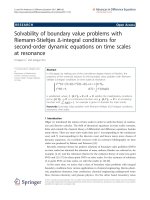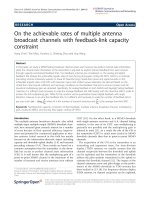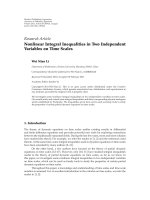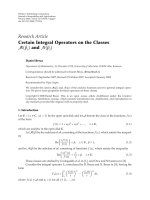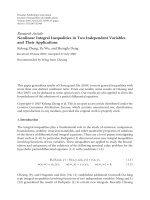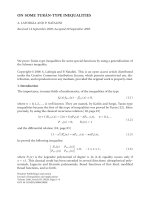Báo cáo hóa học: "ON MULTIPLE HARDY-HILBERT INTEGRAL INEQUALITIES WITH SOME PARAMETERS'''' pdf
Bạn đang xem bản rút gọn của tài liệu. Xem và tải ngay bản đầy đủ của tài liệu tại đây (518.46 KB, 11 trang )
ON MULTIPLE HARDY-HILBERT INTEGRAL INEQUALITIES
WITH SOME PARAMETERS
HONG YONG
Received 19 April 2006; Revised 30 May 2006; Accepted 5 June 2006
By introducing some parameters and norm
x
α
(x ∈ R
n
), we give multiple Hardy-
Hilbert integral inequalities, and prove that their constant factors are the best possible
when parameters satisfy appropriate conditions.
Copyright © 2006 Hong Yong. This is an open access article distributed under the Cre-
ative Commons Attribution License, which permits unrestricted use, distribution, and
reproduction in any medium, provided the original work is properly cited.
1. Introduction
If p>1, 1/p+1/q
= 1, f ≥ 0, g ≥ 0, 0 <
∞
0
f
p
(x) dx < +∞,0<
∞
0
g
q
(x) dx < +∞,thenwe
have the well-known Hardy-Hilbert inequality (see [4]):
+∞
0
f (x)g(x)
x + y
dxdy <
π
sin(π/p)
+∞
0
f
p
(x) dx
1/p
+∞
0
g
q
(x) dx
1/q
, (1.1)
where the constant factor π/sin(π/p) is the best possible. Its equivalent form is
+∞
0
+∞
0
f (x)
x + y
dx
p
dy <
π
sin(π/p)
p
+∞
0
f
p
(x) dx, (1.2)
where the constant factor [π/sin(π/p)]
p
is also the best possible.
Hardy-Hilbert inequalities are important in analysis and in their applications (see [7]).
In recent years, many results (see [1, 3, 8–10]) have been obtained in the research of
Hardy-Hilbert inequality. At present, because of the requirement of higher-dimensional
harmonic analysis and higher-dimensional operator theory, multiple Hardy-Hilbert in-
tegral inequalities are researched (see [5, 6, 11]). Yang [11] obtains the following: if
α
∈ R, n ≥ 2, p
i
> 1(i = 1,2, ,n),
n
i
=1
(1/p
i
) = 1, λ>n− min
1≤i≤n
{p
i
}, f
i
≥ 0, and
Hindawi Publishing Corporation
Journal of Inequalities and Applications
Volume 2006, Article ID 94960, Pages 1–11
DOI 10.1155/JIA/2006/94960
2 Multiple Hardy-Hilbert integral inequalities
0 <
+∞
α
(t − α)
n−1−λ
f
p
i
i
(t)dt < +∞,(i = 1,2, ,n), then
+∞
α
···
+∞
α
1
n
i
=1
x
i
− nα
λ
n
i=1
f
i
x
i
dx
1
dx
n
<
1
Γ(λ)
n
i=1
Γ
1 −
n − λ
p
i
+∞
α
(t − α)
n−1−λ
f
p
i
i
(t)dt
1/p
i
,
(1.3)
where the constant factor (1/Γ(λ))
n
i
=1
Γ(1 − (n − λ)/p
i
) is the best possible.
In this paper, by introducing some parameters and norm
x
α
(x ∈ R
n
), we give mul-
tiple Hardy-Hilbert integral inequalities, and discuss the problem of the best constant
factor. For this reason, we introduce the notation
R
n
+
=
x =
x
1
, ,x
n
: x
1
, ,x
n
> 0
,
x
α
=
x
α
1
+ ···+ x
α
n
1/α
,(α>0),
(1.4)
and we agree on
x
α
<crepresenting {x ∈ R
n
+
: x
α
<c}.
2. Some lemmas
Lemma 2.1 (see [2]). If p
i
> 0, a
i
> 0, α
i
> 0, (i = 1,2, ,n), Ψ(u) is a measurable function,
then
···
x
1
, ,x
n
>0; (x
1
/a
1
)
α
1
+···+(x
n
/a
n
)
α
n
≤1
Ψ
x
1
a
1
α
1
+ ···+
x
n
a
n
α
n
×
x
p
1
−1
1
x
p
n
−1
n
dx
1
dx
n
=
a
p
1
1
a
p
n
n
Γ
p
1
/α
1
Γ
p
n
/α
n
α
1
α
n
Γ
p
1
/α
1
+ ···+ p
n
/α
n
1
0
Ψ(u)u
p
1
/α
1
+···+p
n
/α
n
−1
du,
(2.1)
where the Γ(
·) is Γ-function.
Lemma 2.2. If n
∈ Z
+
, α>0, β>0, λ>0, m ∈ R, 0 <n− m<βλ,andsettingweightfunc-
tion ω
α,β,λ
(m,n, y) as
ω
α,β,λ
(m,n, y) =
R
n
+
1
x
β
α
+ y
β
α
λ
x
−m
α
dx, (2.2)
Hong Yong 3
then
ω
α,β,λ
(m,n, y) =y
n−βλ−m
α
Γ
n
(1/α)
βα
n−1
Γ(n/α)
B
n − m
β
,λ
−
n − m
β
, (2.3)
where the B(
·,·) is β-function.
Proof. By Lemma 2.1,wehave
ω
α,β,λ
(m,n, y) =
R
n
+
1
x
β
α
+ y
β
α
λ
x
−m
α
dy
= lim
r→+∞
···
x
1
, ,x
n
>0; x
α
1
+···+x
α
n
<r
α
×
r
x
1
/r
α
+ ···+
x
n
/r
α
1/α
−m
r
β
x
1
/r
α
+ ···+
x
n
/r
α
β/α
+ y
β
α
λ
x
1−1
1
x
1−1
n
dx
1
dx
n
= lim
r→+∞
r
n
Γ
n
(1/α)
α
n
Γ(n/α)
1
0
ru
1/α
−m
y
β
α
+ r
β
u
β/α
λ
u
n/α−1
du
=
Γ
n
(1/α)
α
n−1
Γ(n/α)
lim
r→+∞
r
0
1
y
β
α
+ t
β
λ
t
n−m−1
dt
=
Γ
n
(1/α)
α
n−1
Γ(n/α)
+∞
0
1
y
β
α
+ t
β
λ
t
n−m−1
dt
=y
n−βλ−m
α
Γ
n
(1/α)
βα
n−1
Γ(n/α)
1
0
1
(1 + u)
λ
u
(n−m)/β−1
du
=y
n−βλ−m
α
Γ
n
(1/α)
βα
n−1
Γ(n/α)
B
n − m
β
,λ
−
n − m
β
.
(2.4)
Hence (2.3)isvalid.
3. Main results
Theorem 3.1. If p>1, 1/p+1/q
= 1, n ∈ Z
+
, α>0, β>0, λ>0, a ∈ R, b ∈ R, 0 <n−
ap <βλ, 0 <n− bq < βλ, f ≥ 0, g ≥ 0,and
0 <
R
n
+
x
(n−βλ)+p(b−a)
α
f
p
(x) dx < +∞, (3.1)
0 <
R
n
+
y
(n−βλ)+q(a−b)
α
g
q
(y)dy <+∞, (3.2)
4 Multiple Hardy-Hilbert integral inequalities
then
R
n
+
f (x)g(y)
x
β
α
+ y
β
α
λ
dxdy
<C
α,β,λ
(a,b, p,q)×
R
n
+
x
(n−βλ)+p(b−a)
α
f
p
(x) dx
1/p
R
n
+
y
(n−βλ)+q(a−b)
α
g
q
(y)dy
1/q
,
(3.3)
R
n
+
y
((n−βλ)+q(a−b))/(1−q)
α
R
n
+
f (x)
x
β
α
+ y
β
α
λ
dx
p
dy
<C
p
α,β,λ
(a,b, p,q) ×
R
n
+
x
(n−βλ)+p(b−a)
α
f
p
(x) dx,
(3.4)
where C
α,β,λ
(a,b, p,q) = (Γ
n
(1/α)/βα
n−1
Γ(n/α))B
1/p
((n − ap)/β,λ − (n − ap)/β)B
1/q
((n −
bq)/β,λ − (n − bq)/β).
Proof. By H
¨
older’s inequality, we have
G :
=
R
n
+
f (x)g(y)
x
β
α
+ y
β
α
λ
dxdy
=
R
n
+
f (x)
x
β
α
+ y
β
α
λ/p
x
b
α
y
a
α
g(y)
x
β
α
+ y
β
α
λ/q
y
a
α
x
b
α
dxdy
≤
R
n
+
f
p
(x)
x
β
α
+ y
β
α
λ
x
bp
α
y
ap
α
dxdy
1/p
×
R
n
+
g
q
(y)
x
β
α
+ y
β
α
λ
y
aq
α
x
bq
α
dxdy
1/q
,
(3.5)
according to the condition of taking equality in H
¨
older’s inequality, if this inequality takes
the form of an equality, then there exist constants C
1
and C
2
, such that they are not all
zero, and
C
1
f
p
(x)
x
β
α
+ y
β
α
λ
x
bp
α
y
ap
α
=
C
2
g
q
(y)
x
β
α
+ y
β
α
λ
y
aq
α
x
bq
α
,a.e.(x, y) ∈ R
n
+
× R
n
+
. (3.6)
Without losing generality, we suppose that C
1
= 0, we may get
x
b(p+q)
α
f
p
(x) =
C
2
C
1
y
a(p+q)
α
g
q
(y), a.e. (x, y) ∈ R
n
+
× R
n
+
, (3.7)
hence, we obtain
x
b(p+q)
α
f
p
(x) = C(constant), a.e. x ∈ R
n
+
, (3.8)
Hong Yong 5
hence, we have
R
n
+
x
(n−βλ)+p(b−a)
α
f
p
(x) dx =
R
n
+
x
(n−βλ)−bq−ap+b(p+q)
α
f
p
(x) dx
= C
R
n
+
x
(n−βλ)−bq−ap
α
dx =∞,
(3.9)
which contradicts (3.1). Hence, and by Lemma 2.2,weobtain
G<
R
n
+
R
n
+
1
x
β
α
+ y
β
α
λ
1
y
ap
α
dy
x
bp
α
f
p
(x) dx
1/p
×
R
n
+
R
n
+
1
x
β
α
+ y
β
α
λ
1
x
bq
α
dx
y
aq
α
g
q
(y)dy
1/q
=
R
n
+
ω
α,β,λ,
(ap,n,x)x
bp
α
f
p
(x) dx
1/p
R
n
+
ω
α,β,λ,
(bq,n, y)y
aq
α
g
q
(y)dy
1/q
=
Γ
n
(1/α)
βα
n−1
Γ(n/α)
B
n − ap
β
,λ
−
n − ap
β
R
n
+
x
(n−βλ)+p(b−a)
α
f
p
(x) dx
1/p
×
Γ
n
(1/α)
βα
n−1
Γ(n/α)
B
n − bq
β
,λ
−
n − bq
β
R
n
+
y
(n−βλ)+q(a−b)
α
g
q
(y)dy
1/q
= C
α,β,λ,
(a,b, p,q)
R
n
+
x
(n−βλ)+p(b−a)
α
f
p
(x) dx
1/p
×
R
n
+
y
(n−βλ)+q(a−b)
α
g
q
(y)dy
1/q
.
(3.10)
Hence, (3.3)isvalid.
Let k
= ((n − βλ)+q(a − b))/(1 − q), for 0 <h<l<+∞,setting
g
h,l
(y) =
⎧
⎪
⎪
⎪
⎨
⎪
⎪
⎪
⎩
y
k
α
R
n
+
f (x)
x
β
α
+ y
β
α
λ
dx
p/q
, h<y
α
<l,
0, 0 <
y
α
≤ h or y
α
≥ l,
g(y) =y
k
α
R
n
+
f (x)
x
β
α
+ y
β
α
λ
dx
p/q
, y ∈ R
n
+
,
(3.11)
by (3.1), for sufficiently small h>0andsufficiently large l>0, we have
0 <
h<y
α
<l
y
(n−βλ)+q(a−b)
α
g
q
h,l
(y)dy <+∞. (3.12)
6 Multiple Hardy-Hilbert integral inequalities
Hence, by (3.3), we have
h<y
α
<l
y
(n−βλ)+q(a−b)
α
g
q
(y)dy
=
h<y
α
<l
y
k(1−q)
α
g
q
(y)dy =
h<y
α
<l
y
k
α
R
n
+
f (x)
x
β
α
+ x
β
α
λ
dx
p
dy
=
h<y
α
<l
y
k
α
R
n
+
f (x)
x
β
α
+ y
β
α
λ
dx
p/q
R
n
+
f (x)
x
β
α
+ y
β
α
λ
dx
dy
=
R
n
+
f (x)g
h,l
(y)
x
β
α
+ y
β
α
λ
dxdy < C
α,β,λ,
(a,b, p,q)
R
n
+
x
(n−βλ)+p(b−a)
α
f
p
(x) dx
1/p
×
R
n
+
y
(n−βλ)+q(a−b)
α
g
q
h,l
(y)dy
1/q
= C
α,β,λ,
(a,b, p,q)
R
n
+
x
(n−βλ)+p(b−a)
α
f
p
(x)dx
1/p
×
h<y
α
<l
y
(n−βλ)+q(a−b)
α
g
q
(y)dy
1/q
,
(3.13)
it follows that
h<y
α
<l
y
(n−βλ)+q(a−b)
α
g
q
(y)dy <C
p
α,β,λ,
(a,b, p,q)
R
n
+
x
(n−βλ)+p(b−a)
α
f
p
(x) dx. (3.14)
For h
→ 0
+
, l → +∞,weobtain
0 <
R
n
+
y
(n−βλ)+q(a−b)
α
g
q
(y)dy
≤ C
p
α,β,λ,
(a,b, p,q)
R
n
+
x
(n−βλ)+p(b−a)
α
f
p
(x) dx < +∞,
(3.15)
hence, by (3.3), we obtain
R
n
+
y
((n−βλ)+q(a−b))/(1−q)
α
R
n
+
f (x)
x
β
α
+ y
β
α
λ
dx
p
dy
=
R
n
+
f (x)g(y)
x
β
α
+ y
β
α
λ
dxdy < C
α,β,λ,
(a,b, p,q)
R
n
+
x
(n−βλ)+p(b−a)
α
f
p
(x) dx
1/p
×
R
n
+
y
(n−βλ)+q(a−b)
α
g
q
(y)dy
1/q
=C
α,β,λ,
(a,b, p,q)
R
n
+
x
(n−βλ)+p(b−a)
α
f
p
(x) dx
1/p
×
R
n
+
y
((n−βλ)+q(a−b))/(1−q)
α
R
n
+
f (x)
x
β
α
+ y
β
α
λ
dx
p
dy
1/q
.
(3.16)
Hence, we can obtain (3.4).
Hong Yong 7
Remark 3.2. If f and g do not satisfy (3.1)and(3.2), by the proof of Theorem 3.1,wecan
obtain
R
n
+
f (x)g(y)
x
β
α
+ y
β
α
λ
dxdy
≤C
α,β,λ
(a,b, p,q) ×
R
n
+
x
(n−βλ)+p(b−a)
α
f
p
(x)dx
1/p
R
n
+
y
(n−βλ)+q(a−b)
α
g
q
(y)dy
1/q
,
(3.17)
R
n
+
y
((n−βλ)+q(a−b))/(1−q)
α
R
n
+
f (x)
x
β
α
+ y
β
α
λ
dx
p
dy
≤ C
p
α,β,λ
(a,b, p,q) ×
R
n
+
x
(n−βλ)+p(b−a)
α
f
p
(x) dx.
(3.18)
Remark 3.3. By (3.4),wecanalsoobtain(3.3), hence (3.4)and(3.3) are equivalent.
Theorem 3.4. If p>1, 1/p+1/q
= 1, n ∈ Z
+
, α>0, β>0, λ>0, a ∈ R, b ∈ R, 0 <n−
ap <βλ, ap+ bq = 2n − βλ, f ≥ 0, g ≥ 0,and
0 <
R
n
+
x
b(p+q)−n
α
f
p
(x) dx < +∞,
0 <
R
n
+
y
a(p+q)−n
α
g
q
(y)dy <+∞,
(3.19)
then
R
n
+
f (x)g(y)
x
β
α
+ y
β
α
λ
dxdy
<
Γ
n
(1/α)
βα
n−1
Γ(n/α)
B
n − ap
β
,λ
−
n − ap
β
×
R
n
+
x
b(p+q)−n
α
f
p
(x) dx
1/p
R
n
+
y
a(p+q)−n
α
g
q
(y)dy
1/q
,
(3.20)
R
n
+
y
(a(p+q)−n)/(1−q)
α
R
n
+
f (x)
x
β
α
+ y
β
α
λ
dx
p
dy
<
Γ
n
(1/α)
βα
n−1
Γ(n/α)
B
n − ap
β
,λ
−
n − ap
β
p
R
n
+
x
b(p+q)−n
α
f
p
(x) dx,
(3.21)
where the constant factors (Γ
n
(1/α)/βα
n−1
Γ(n/α))B((n − ap)/β,λ − (n − ap)/β) and
[(Γ
n
(1/α)/βα
n−1
Γ(n/α))B((n − ap)/β,λ − (n − ap)/β)]
p
are all the best possible.
Proof. Since ap+ bq
= 2n − βλ,wehave
n
− bq = n − (2n − βλ − ap) = βλ − (n − ap), (3.22)
8 Multiple Hardy-Hilbert integral inequalities
hence, by 0 <n
− ap < βλ,weobtain0<n− bq < βλ,and
(n
− βλ)+p(b − a) = b(p + q) − n,(n − βλ)+q(a − b) = a(p + q) − n,
n
− ap
β
= λ−
n − bq
β
, λ
−
n − ap
β
=
n − bq
β
.
(3.23)
By Theorem 3.1,(3.20)and(3.21)arevalid.
If the constant factor K
1
:= (Γ
n
(1/α)/βα
n−1
Γ(n/α))B((n − ap)/β,λ − (n − ap)/β)in
(3.20) is not the best possible, then there exists a positive constant K<K
1
,suchthat
(3.20) is still valid when we replace K
1
by K.
In particular, for 0 <ε<q(n
− ap), we take
f
ε
(x) =x
−bq−ε/p
α
, g
ε
(y) =y
−ap−ε/q
α
, (3.24)
by (3.17) and the properties of limit, when δ>0issufficiently small, we have
x
α
>δ
R
n
+
f
ε
(x) g
ε
(y)
x
β
α
+ y
β
α
λ
dxdy
≤ K
x
α
>δ
x
b(p+q)−n
α
f
p
ε
(x) dx
1/p
y
α
>δ
y
a(p+q)−n
α
g
q
ε
(y)dy
1/q
= K
x
α
>δ
x
−n−ε
α
1/p
y
α
>δ
y
−n−ε
α
dy
1/q
= K
x
α
>δ
x
−n−ε
α
dx.
(3.25)
On the other hand, by Lemma 2.2,wehave
x
α
>δ
R
n
+
f
ε
(x) g
ε
(y)
x
β
α
+ y
β
α
λ
dxdy
=
x
α
>δ
x
−bq−ε/p
α
R
n
+
1
x
β
α
+ y
β
α
λ
y
−ap−ε/q
α
dydx
=
x
α
>δ
x
−bq−ε/p
α
ω
α,β,λ
ap+
ε
q
,n,x
dx
=
Γ
n
(1/α)
βα
n−1
Γ(n/α)
B
1
β
n − ap−
ε
q
,λ −
1
β
n − ap−
ε
q
x
α
>δ
x
−n−ε
α
dx.
(3.26)
Hence, we obtain
Γ
n
(1/α)
βα
n−1
Γ(n/α)
B
1
β
n − ap−
ε
q
,λ −
1
β
n − ap−
ε
q
≤
K, (3.27)
for ε
→ 0
+
,wehave
K
1
=
Γ
n
(1/α)
βα
n−1
Γ(n/α)
B
n − ap
β
,λ
−
n − ap
β
≤
K, (3.28)
Hong Yong 9
which cont radicts the fact that K<K
1
.Hencetheconstantfactorin(3.20)isthebest
possible.
Since (3.21)and(3.20) are equivalent, the constant factor in (3.21)isalsothebest
possible.
4. Some corollaries
Corollary 4.1. If p>1, 1/p+1/q
= 1, n ∈ Z
+
, α>0, β>0, λ>0, f ≥ 0, g ≥ 0,and
0 <
R
n
+
x
(n−βλ)(p−1)
α
f
p
(x) dx < +∞,
0 <
R
n
+
y
(n−βλ)(q−1)
α
g
q
(y)dy <+∞,
(4.1)
then
R
n
+
f (x)g(y)
x
β
α
+ y
β
α
λ
dxdy
<
Γ
n
(1/α)
βα
n−1
Γ(n/α)
B
λ
p
,
λ
q
R
n
+
x
(n−βλ)(p−1)
α
f
p
(x)dx
1/p
R
n
+
y
(n−βλ)(q−1)
α
g
q
(y)dy
1/q
,
R
n
+
y
βλ−n
α
R
n
+
f (x)
x
β
α
+ y
β
α
λ
dx
p
dy
<
Γ
n
(1/α)
βα
n−1
Γ(n/α)
B
λ
p
,
λ
q
p
R
n
+
x
(n−βλ)(p−1)
α
f
p
(x) dx,
(4.2)
where the constant factors in (4.2) are all the best possible.
Proof. If we take a
= n/p − βλ/p
2
, b = n/q − βλ/q
2
in Theorem 3.4,(4.2)canbeobtained.
Remark 4.2. If we take n = λ = 1in(4.2),wecanobtaintheresultsof[10]:
+∞
0
f (x)g(y)
x
β
+ y
β
dxdy
<
π
βsin(π/p)
+∞
0
x
(p−1)(1−β)
f
p
(x) dx
1/p
+∞
0
y
(q−1)(1−β)
g
q
(y)dy
1/q
,
+∞
0
y
β−1
+∞
0
f (x)
x
β
+ y
β
dx
p
dy <
π
βsin(π/p)
p
+∞
0
x
(p−1)(1−β)
f
p
(x) dx,
(4.3)
where the constant factors in (4.3) are all the best possible.
10 Multiple Hardy-Hilbert integral inequalities
If we take n
= β = 1in(4.2), we can obtain
+∞
0
f (x)g(y)
(x + y)
λ
dxdy
<B
λ
p
,
λ
q
+∞
0
x
(1−λ)(p−1)
f
p
(x) dx
1/p
+∞
0
y
(1−λ)(q−1)
g
q
(y)dy
1/q
,
+∞
0
y
λ−1
+∞
0
f (x)
(x + y)
λ
dx
p
dy <B
p
λ
p
,
λ
q
+∞
0
x
(1−λ)(p−1)
f
p
(x) dx,
(4.4)
where the constant factors in (4.4) are all the best possible.
Corollary 4.3. If p>1, 1/p+1/q
= 1, n ∈ Z
+
, λ>0, np+ λ − 2n>0 , nq + λ − 2n>0
f
≥ 0, g ≥ 0,and
0 <
R
n
+
x
n−λ
α
f
p
(x) dx < +∞,
0 <
R
n
+
y
n−λ
α
g
q
(y)dy <+∞,
(4.5)
then
R
n
+
f (x)g(y)
x
α
+ y
α
λ
dxdy
<B
np+ λ − 2n
p
,
nq + λ
− 2n
q
R
n
+
x
n−λ
α
f
p
(x) dx
1/p
R
n
+
y
n−λ
α
g
q
(y)dy
1/q
,
R
n
+
y
(n−λ)/(1−q)
α
R
n
+
f (x)
x
α
+y
α
λ
dx
p
dy<B
p
np+λ−2n
p
,
nq+λ
−2n
q
R
n
+
x
n−λ
α
f
p
(x)dx,
(4.6)
where the constant factors in (4.6) are all the best possible.
Proof. If we take β
= 1, a = b = (2n − λ)/pqin Theorem 3.4,(4.6)canbeobtained.
Remark 4.4. If we take n = 1in(4.6), we can obtain the results of [1]:
+∞
0
f (x)g(y)
(x + y)
λ
dxdy
<B
p + λ − 2
p
,
q + λ
− 2
q
+∞
0
x
1−λ
f
p
(x) dx
1/p
+∞
0
y
1−λ
g
q
(y)dy
1/q
,
+∞
0
y
(1−λ)/(1−q)
+∞
0
f (x)
(x + y)
λ
dx
p
dy <B
p
p + λ − 2
p
,
q + λ
− 2
q
+∞
0
x
1−λ
f
p
(x) dx,
(4.7)
where the constant factors in (4.7) are all the best possible.
If we take other appropriate parameters, we can obtain many new inequalities.
Hong Yong 11
References
[1] Y. Bicheng, On Hardy-Hilbert’s integral inequality, Journal of Mathematical Analysis and Appli-
cations 261 (2001), no. 1, 295–306.
[2] G. M. Fichtingoloz, ACourseinDifferential and Integral Calculus, Renmin Jiaoyu, Beijing, 1959.
[3] M. Gao, T. Li, and L. Debnath, Some improvements on Hilbert’s integral inequality,Journalof
Mathematical Analysis and Applications 229 (1999), no. 2, 682–689.
[4] G. H. Hardy, J. E. Littlewood, and G. P
´
olya, Inequalities, Cambridge University Press, Cam-
bridge, 1952.
[5] Y. Hong, All-sided generalization about Hardy-Hilbert integral inequalities, Acta Mathematica
Sinica (China) 44 (2001), no. 4, 619–626.
[6] K. Jichang, Applied Inequalities, China Shandong Science and Technology Press, Jinan, 2004.
[7] D. S. Mitrinovi
´
c, J. E. Pe
ˇ
cari
´
c,andA.M.Fink,Inequalities Involving Functions and Their Inte-
grals and Derivatives, Mathematics and Its Applications (East European Series), vol. 53, Kluwer
Academic, Dordrecht, 1991.
[8] B.G.Pachpatte,On some new inequalities similar to Hilbert’s inequality, Journal of Mathematical
Analysis and Applications 226 (1998), no. 1, 166–179.
[9] B. Yang, A general Hardy-Hilbert’s integral inequality with a best constant, Chinese Annals of
Mathematics. Series A. 21 (2000), no. 4, 401–408.
[10]
, An extension of Hardy-Hilbert’s inequality, Chinese Annals of Mathematics. Series A. 23
(2002), no. 2, 247–254.
[11]
, A multiple Hardy-Hilbert integral inequality, Chinese Annals of Mathematics. Series A.
24 (2003), no. 6, 743–750.
Hong Yong: Department of Mathematics, Guangdong University of Business Study,
Guangzhou 510320, China
E-mail address:
